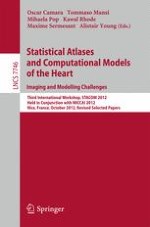2013 | Book
Statistical Atlases and Computational Models of the Heart. Imaging and Modelling Challenges
Third International Workshop, STACOM 2012, Held in Conjunction with MICCAI 2012, Nice, France, October 5, 2012, Revised Selected Papers
Editors: Oscar Camara, Tommaso Mansi, Mihaela Pop, Kawal Rhode, Maxime Sermesant, Alistair Young
Publisher: Springer Berlin Heidelberg
Book Series : Lecture Notes in Computer Science
